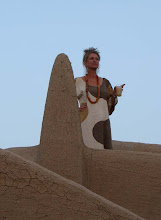
All good school children remember of course that the fall of Constantinople in 1453 is regarded as the beginning of the Renaissance since Italy was subsequently overrun by Classical scholars escaping the Ottomans. This had the effect of waking the Italians from their medieval slumber and henceforth they started to draw a lot better for one thing.
Lesser known refugees from Constantinople included skilful bead makers who taught the Venetians in particular to make glass beads. And from Venice these beads travelled as trade beads into the furthest corners of Africa where they were exchanged for gold, slaves, palm oil and other commodities. Venetian glass beads are still found in the markets of Africa, but they are becoming expensive and rare. They are now migrating back to where they came from and are found in the markets and chic jewellery stores of Europe and America.
African trade beads and their peregrinations is a fascinating subject. An intimate knowledge of trade beads brings knowledge of history itself.
Birgit has such knowledge, although she modestly begs me to write that she is only a student of trade beads. She comes to Africa each winter and buys beads for her stall in Amsterdam market during the summer months. She does a lot of business with Kissiman above.


0 Comments:
Post a Comment
<< Home